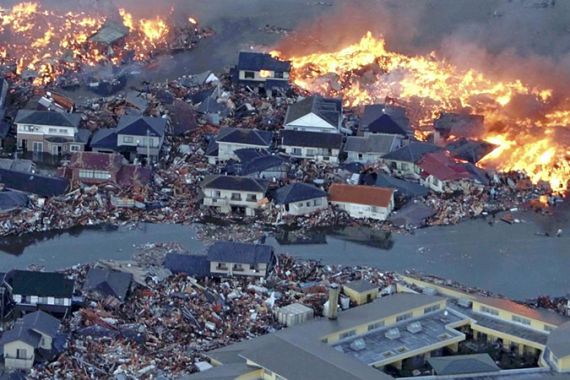Japan tsunami exacts heavy toll two years on
Traumatised residents complain of slow reconstruction following twin disasters of tsunami and nuclear meltdown.

Just above the din of tractors and backhoes sifting through rubble, Usuzawa Ryoichi begins to sob. In the two years since the tsunami in Japan, the 64-year-old has only returned a handful of times to the place where his home used to be.
Before we even begin to talk, emotions overtake him. Standing on the foundation of his former house and looking at the vast expanse of what used to be a busy residential neighbourhood in Otsuchi, his body shakes, as tears mist over his glasses. His beloved dog Taro, whom he rescued from the black churning waters, is clutched tightly in his arms, whimpering.
“When I come here, I see all the faces of the people being washed away, every single one of them, my neighbours, my friends. I can’t shake them.”
Like many survivors, Usuzawa lives in a state of semi-depression. If the government had rebuilt and provided more jobs, he believes he would be doing much better. Instead, he and his wife try to find meaning in a temporary shelter. “We’ve watched families break apart. Domestic abuse is on the rise too, it’s just a mess.”
Two years since Japan’s worst disaster in modern times, 310,000 people are still without permanent housing.
It’s become public knowledge that of the $200bn pledged by the government for reconstruction, some has been used to fund things such as advertising projects in Tokyo for unrelated building projects, or caught up in the country’s infamous red tape.
Since winning election last December, Japan’s new prime minister, Shinzo Abe, has overhauled the agency in charge of reconstruction. The former governing party, the DPJ, created the bureau after the disaster to bypass the government’s bureaucracy. So far, though, many say it has failed to carry out its mission.
‘We are doing our best’
|
Fukushima forests found to be radioactive |
The reconstruction office for Otsuchi is a two-hour drive away, in Morioka, the capital of the prefecture. Taiji Yasuda, who has been second-in-charge since last July, admits there have been problems. But he blames a shortage of staff, saying he has fewer than 50 people working on rebuilding communities along a lengthy stretch of coastline.
“We understand that people are undergoing extreme social stress and we want to hear from them,” Yasuda says. “But we also want to tell them we are speeding up construction, that everything will be faster.”
Authorities say progress has been slow because of disagreements over land rights and fierce debates over how exactly to rebuild. “Yes, there have been challenges, but the planning stage is over now,” says Yasuda. “We have already started building permanent homes. In the next few years you will see a great deal of change. We are doing our best.”
Usuzawa, though, is sceptical. A former government worker, he says he’s tried many times, with other residents, to present to planners their ideas on how to rebuild their town. Instead, he says they’ve been met with silence.
“They’ve hired design companies from far-away places like Tokyo, and we see these people every night spending their high salaries entertaining themselves in our communities. That is our money, that should be going directly to helping our people.”
Usuzawa says many of the youth have left for jobs elsewhere because there is simply nothing for them to do here. Deeply attached to his town, he refuses to leave. “You feel like a crazed person, like you could explode with anger at anytime … They tell us they’re making progress … We don’t see it.”
Several hundred kilometres south, near the destroyed Fukushima nuclear plant, residents also complain about the slow pace of the cleanup and rebuilding.
Nuclear meltdown
| By The Numbers |
|
March 11, 2011 Japan moved 2.4m closer to North America
38.9-metre max wave height
15,881 people killed
45,700 buildings destroyed |
It’s been more than a year since TEPCO, the plant’s operator, announced that reactors had stopped spewing radioactive material. Still, engineers have been unable to figure out how they will remove the dangerous fuel rods. Analysts say it could take 40 years before the Fukushima plant is fully shut down. Meanwhile, TEPCO says it is running out of space to store contaminated water used to cool the reactors, and is considering dumping it into the ocean.
The nuclear meltdown following the tsunami spread radiation over large swathes of northeastern Japan. While it’s estimated the amount of radiation emitted was one-tenth that of the Chernobyl disaster, it spread over an area far more densely populated.
Two years later, TEPCO faces renewed accusations that it has not been forthcoming in compensating those who suffered from the fallout.
On a table in Tsuguo Hirota’s small office, reams of case files are piling up. He is one of several lawyers representing more than 1,700 people suing the power plant operator. Hirota acknowledges new figures show more than 40 percent of children in the Fukushima area have tested positive for thyroid abnormalities. “Lots of young families have serious concerns,” he says. “Children are some of the most susceptible to radiation.”
But rather than argue on medical grounds, which Hirota acknowledges is difficult, he says most are suing on psychological grounds. “We don’t want to get into the medical debate. What we are saying is that our lives have been irreversibly changed because of TEPCO’s ineptitude.”
Hirota himself is part of the lawsuit. He has waived the legal fees, saying he and his family belong to this suffering community. “People are haunted by uncertainty. They can’t drink the water, they can’t eat local produce … Kids can’t play outdoors anymore.”
What has angered people the most, Hirota says, is the lack of input. Without consultation, he says, some residents in Iwake prefecture, where he lives, received $850 payments from TEPCO. “We feel we had no voice or say in the matter; that TEPCO is dictating how much it pays out. We see it as symbolic of their irresponsibility.”
Hirota describes meetings with TEPCO’s lawyers and representatives as lacking any meaningful discussion. “They don’t answer questions directly and do the same thing every time I present a case – they stand up, bow, say they are sorry and that they are doing their best.”
Ruined lives
|
Japan company admits it played down nuclear plant concerns |
| |
Just 40 kilometres away from the Fukushima plant, Mikio Watanabe stands in silence by the tree where his wife killed herself. A farmer all his life, he is not much for words or for showing emotion.
Yet when he returns to the home he and his wife built, he is filled with anger. The house and the forests surrounding it remain heavily contaminated with cesium, and while the government allows visits during the day, residents are not allowed to stay overnight.
It was during one of those visits that Watanabe says his wife chose to end her life. “I was so stressed myself, and I regret I didn’t see how severely she was suffering, it fills me with remorse.”
Before the nuclear disaster, Watanabe says her wife was always cheerful, enjoying their life tending to chickens, in this remote and beautiful area of Fukushima. But when forced to evacuate, they had to move to a temporary shelter, and forced to stay indoors. Having lost the life they so enjoyed, he says his wife slid into depression.
“The night before she killed herself, she held onto my hands so hard, and refused to let go.”
The next morning, Watanabe was outdoors alone, tending to the garden, when he noticed a flame go up by a tree in the front yard. It was only a few hours later that he discovered his wife had set herself on fire.
Watanabe is also suing TEPCO. It’s estimated the company will likely spend $250bn in compensating residents and in cleaning up radiation-contaminated communities.
What Watanabe says he would like TEPCO and others to realise is that the disaster ruined people’s lives. “If I didn’t live through this myself, I too wouldn’t understand how tough it is. Things will never be the same.”
 The earthquake:
The earthquake: